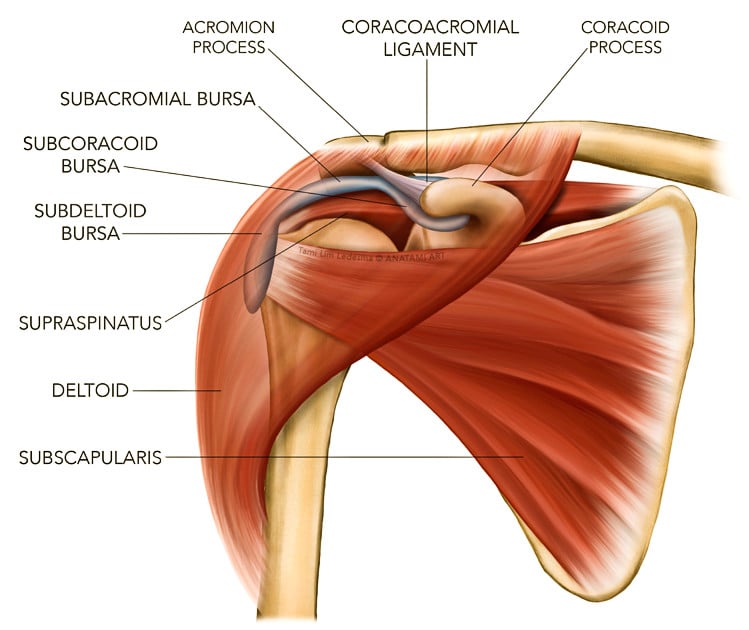Call Us
It’s a nice summer day and you’ve been spending all day playing baseball. You begin to wind your arm for a pitch but a sudden pinch in the shoulder stops you in your tracks. You shake it off, thinking it’s nothing, and wind up again for another pitch but the pain is worse this time. You may have a classic case of shoulder impingement syndrome.
What is shoulder impingement?
Shoulder impingement syndrome is a condition that make overhead arm movements difficult and painful. Before we dive into the mechanism of shoulder impingement, it’s important to first understand the anatomy of the shoulder joint.
Anatomy
The shoulder is a ball and socket joint formed by the arm bone and shoulder blade. The socket is shallow, which is the reason that shoulders are the most mobile joints in the body. Surrounding the shoulder joint are the four rotator cuff muscles that branch off the shoulder blade. They ensure that the ball stays in the center of the socket during movement.
Above the ball, there is a bony roof that is formed by the shoulder blade and collar bone. The space between the ball and roof is known as the subacromial space and it contains the supraspinatus and bursa. The supraspinatus is one of the four rotator cuff muscles and a bursa is a sac of fluid that reduces friction between local structures.
Shoulder mechanics
Raising the arm is a complex movement that involves an upward movement of the arm and rotation of the shoulder blade. The movements of these structures are meticulously controlled by muscles around your shoulder and shoulder blade. When each part is moving correctly, the subacromial space will be preserved, providing you with full shoulder range of motion and strength.
Mechanical errors
Shoulder impingement occurs when the subacromial space begins to narrow. As a result, the supraspinatus tendon or bursa becomes pinched between the arm bone and bony roof, which creates a sharp pain. This commonly occurs with activities that involve raising your arm overhead.
How do you get shoulder impingement?
Let’s review some risk factors for shoulder impingement.
Overuse
Many activities and sports involve repetitive overhead shoulder movements. Let’s use painting as an example. As you’re lifting your arm to paint a wall, your shoulder muscles are working hard to ensure that the movement is mechanically sound. As your muscles begin to fatigue, the movement pattern will deteriorate. As a result, the subacromial space will begin to slowly narrow until the structures beneath become pinched.
Trauma
Accidents happen and it may involve a direct impact to the shoulder. The supraspinatus tendon is located along the side of the shoulder and is often a common structure to be irritated with trauma. An integral component of the rotator cuff complex, an injury to the supraspinatus will negatively impact its ability to maintain alignment of the shoulder joint. As a result, a shift in the position of the ball will reduce subacromial space leading to shoulder impingement.
Structural Derangement
Any structural damage or degenerative changes of the shoulder complex can lead to shoulder impingement syndrome. Here are a few common structural derangements:
- Torn shoulder labrum
- Torn rotator cuff muscle
- Bony spur secondary to arthritic changes
Poor shoulder mechanics
Moving the shoulder is a complex process involving the arm bone, shoulder blade, collar bone, and spine. Each part plays a pivotal role to ensure that the movement is mechanically sound and that the subacromial space is maintained. Any disruptions to these individual parts can result in subacromial impingement syndrome. For example, weakness in some of the muscles surrounding the shoulder blade will reduce its ability to upwardly rotate leading to narrowing of the subacromial space.
Poor Posture
Posture plays an important role with shoulder mobility. Poor posture generally involves rounding of your shoulders and spine. This will put the shoulder blade in a poor position to rotate, leading to shoulder impingement when raising the arm above the head.
To help gain an appreciation of the importance of posture with shoulder mobility, try this test. Sit on a chair with your best posture and raise your arm. You will have full range of motion and experience minimal pain. Now slump forward, fully round your spine, and raise your arm. You will notice a loss in range of motion and possibly a pinching sensation in the shoulder. This, again, is due to the altered position of the shoulder blade.
What does shoulder impingement feel like?
The symptoms of shoulder impingement will vary depending on the stage of recovery.
Acute
When shoulder impingement is acute, these are some symptoms that are commonly experienced:
- Local inflammation along the front of the shoulder
- Pain that may radiate to the side of the arm
- Pain on touch along the side of the arm
- Your shoulder may hurt all the time, even at rest
- Increased pain when lifting and lowering your arm
- Activities involving reaching may create a sharp pain
- Increased pain at night due to inflammation
- Pain that will wake you up at night if you roll onto the shoulder
Chronic
If untreated, you may start to develop chronic symptoms. Here are some symptoms that you may experience:
- Pain and stiffness that is only produced with overhead activities
- A loss of range of motion when lifting up your arm
- Difficulty with activities involving using your hands behind your back (ex. putting on a jacket)
- Increased pain when lying on the affected shoulder
- Decreased strength in the shoulder
How long does shoulder impingement take to heal?
A common question that we get is “will my shoulder impingement go away and if so, how long will it take?” The answer depends on the root cause of the shoulder impingement. If the shoulder issue is a result of trauma, overuse, poor shoulder mechanics, and posture, it will recover within 4-8 weeks with physiotherapy treatment. However, if the issue is stemming from structural derangements, a surgical intervention may be required followed by rehabilitation.
If you have been experiencing chronic shoulder pain and suspect shoulder impingement, we recommend that you see a physiotherapist to determine the cause of the issue. The “wait and see” approach may not always lead to recovery.
What should you not do with shoulder impingement?
To prevent your shoulder impingement from getting worse, we recommend that you avoid any activities that will aggravate the subacromial structures. Here are a few tips to consider:
- Be cautious with any activities that involve overhead movements (ex. tennis, swimming, baseball, painting, lifting, window washing, etc.)
- To avoid overusing your shoulder, plan breaks ahead of time with any activities involving repetitive overhead movements (ex. painting)
- Avoid sleeping on the affected side as prolonged compression can lead to further aggravation
- Correct your sitting and standing posture by keeping your spine upright and your shoulder blades back
Incorporate shoulder strengthening exercises into your fitness routine
How is shoulder impingement diagnosed?
A Physiotherapist
When you see your physiotherapist, he or she will begin by taking a thorough history of your injury. Some questions will include how the injury occurred, activities that currently aggravate your shoulder, history of previous shoulder injuries, and other forms of treatments that you may have tried. This will help your physiotherapist gain a deeper insight into the issue.
A physical examination will follow. Due to the complex nature of shoulder impingement syndrome, your physiotherapist will perform a thorough assessment by looking at your shoulder, shoulder blade, and spine. This will allow your physiotherapist to determine the root cause of your shoulder impingement syndrome and design a custom treatment plan.
Medical Diagnostics
X-rays: X-rays may be recommended by your family physician to further examine the bony structures of your shoulder. With regards to shoulder impingement syndrome, x-rays are useful tools to detect bone spurs or degenerative changes that may be contributing to your symptoms.
Ultrasound and/or MRI: Ultrasounds and MRI may be prescribed if soft tissues (ex. muscles, bursa, labrum, etc.) are suspected to be the root cause of the shoulder impingement. In addition, they are useful to identify any fluid build up in the subacromial region.
Clinical Tip for Shoulder Impingement Diagnosis
Although diagnostic imaging is a useful tool to investigate any structural abnormalities in the shoulder, they can also be full of red herrings. Rotator cuff tears and degenerative changes are common findings on imaging with aging as the tissues undergo wear and tear. They will often go unnoticed as they are generally asymptomatic. It’s important to remember to read the findings with a grain of salt and understand that the detected abnormalities may not be the cause of your pain.
How is shoulder impingement treated?
Physiotherapy
Once the root cause of the shoulder impingement has been identified, your physiotherapist will create a treatment plan that involves a combination of hands on therapy, home exercises, and education. The treatment plan will involve two phases. The first phase will focus on reducing your shoulder pain and restoring any range of motion that may have been lost. The second phase will begin re-strengthening your shoulder and assist with helping you return to pre-injury activities. Education will also be provided to help you prevent future episodes of shoulder impingement syndrome.
Medication
To assist with pain-management and swelling, your family physician may provide non-steroidal anti-inflammatory medication. In some cases, this may help to accelerate your recovery as it will increase your tolerance to physiotherapy.
Cortisone Injection
When pain and inflammation becomes difficult to manage with oral medication and physiotherapy exercises, your family physician may recommend a cortisone injection. The injection will contain a corticosteroid medication and will improve your shoulder pain and range of motion. However, it is important to note that having a cortisone injection is not a solution to shoulder impingement. It simply provides temporary relief and the underlying root cause will still need to be addressed.
Surgical treatment
If your shoulder impingement syndrome is determined to be caused by structural deformities, a surgical intervention may be recommended. The goal of surgery will be to increase the space under the subacromial region to prevent the structures from being repeatedly pinched. This is commonly performed using minimally invasive arthroscopic surgery. However, more severe cases may involve an open surgical technique.
Shoulder impingement syndrome is a common condition and can be effectively treated with proper management. If you have any questions or require assistance, we recommend that you set up an appointment with one of our physiotherapists. Our team of physiotherapists have extensive experience assessing and treating shoulder conditions. If you would like to speak with us first, we offer a complementary 10-minute phone consult with a Registered Physiotherapist.

Questions? We're happy to help!
Choosing the right service provider can be a big decision. We’re dedicated to answering any questions you have to help you make the best choice. Contact us today and ask us anything!
Call us at (416) 238-6749







